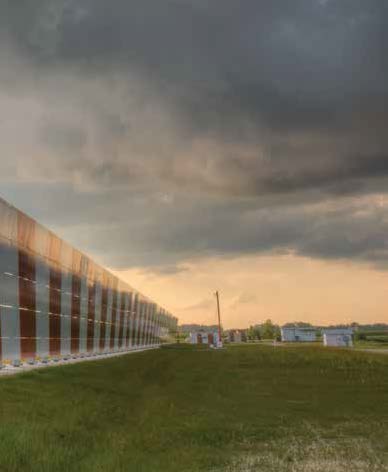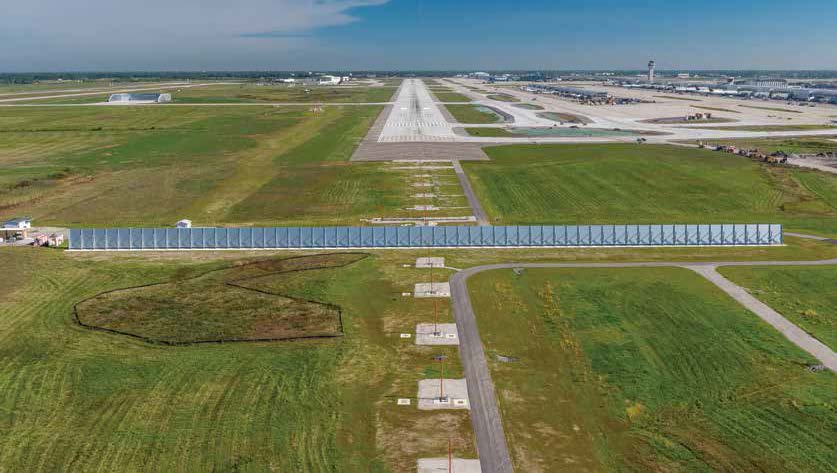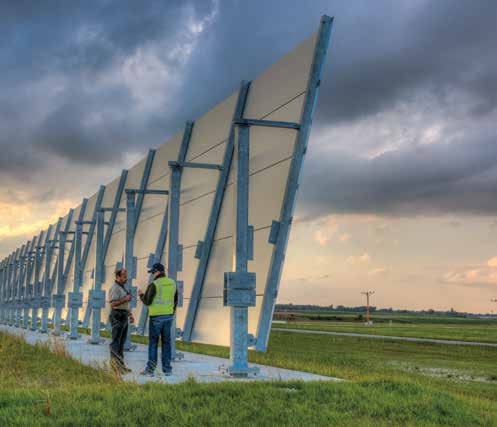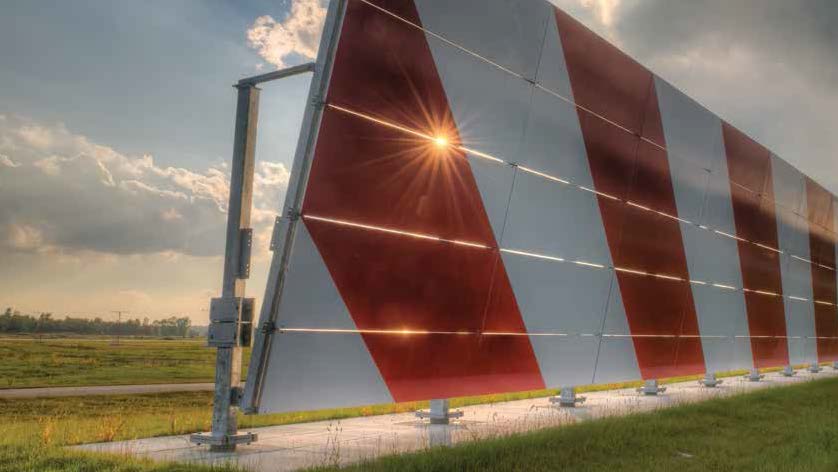Passengers touching down on Runway 4R at Detroit Metropolitan Wayne County International Airport (DTW) probably assume that the long, plain structure off the end of Runway 22L is a fence or billboard space ready for advertisers. (See photo)
Actually, it’s the back side of a visual screen strategically positioned on the airport’s end-around taxiway, beyond the runway safety area. The front red-and-white-striped side, which faces Runway 22L, serves as a sight barrier between departing and arriving aircraft. The screen is designed to mask aircraft on the end-around taxiway for departing pilots, so they can more easily detect aircraft that are in front of the screen, on the far end of their departure runway. By providing a visual point of reference, the brightly striped panels help pilots discern the two critically different types of ground traffic.
Built at a cost of about $1 million, DTW’s 708-foot-long structure is the third visual screen installed at a U.S. airport. The first two were built at Dallas/Fort Worth International (DFW).
Work crews constructed DTW’s screen in 82 days, from April 7 to June 27 last year, without disrupting any flights, note airport officials. To keep airfield traffic flowing smoothly, crews were not allowed to use equipment taller than 25 feet while the runway was open. The contractor also had the option of working from 9 p.m. to 9 a.m., when the runway was closed.
 factsfigures factsfiguresProject: Visual Screen Location: Detroit Metropolitan Wayne County Int’l Airport Placement: On End-Around Taxiway Q, running perpendicular to centerline of Runway 22L Cost: $1,019,360 Size: 708 ft. long, 20 ft. tall Design & Engineering: Michigan Aviation Partners, a joint venture between Kimley-Horn and Tucker, Young, Jackson, Tull Construction: Motor City Electric Utilities/Hy-Lite Construction Joint Venture Key Benefit: Enhances safety by adding a visual barrier between departing & arriving pilots |
Why Taxi Around?
Although end-around taxiways are relatively new, installations at a handful of high profile airports have captured the industry’s attention by reducing airfield wait times and fuel costs – thus benefiting airlines and passengers alike. Because aircraft spend less time idling, decreased emissions are also a plus.
Hartsfield-Jackson Atlanta International (ATL) has the distinction of being the first U.S. airport to install an end-around taxiway. Commissioned in spring 2007, Taxiway V allows aircraft arriving on Runway 26R to taxi around the end of the adjacent Runway 26L instead of waiting for clearance to cross over it. Initial research predicted that ATL’s end-around taxiway would increase overall airfield efficiency by 30% and save more than $27 million per year in taxiing and flight delay costs.
According to FAA personnel, 12 U.S. airports now have end-around taxiways, and two more installations are under consideration. ATL and DFW are the only locations with end-around taxiways that don’t include specific operational restrictions, they note.
Why Add a Screen?
Amid early enthusiasm about the operational benefits of end-around taxiways, the FAA continued to focus on their safety and engaged the Mitre Center for Advanced Aviation System Development to help identify potential risks regarding their use. (Mitre Center is the same not-for-profit entity involved in the development of FAA’s NextGen air traffic system.)
“During these evaluations, it became clear that pilots were having difficulty distinguishing between EAT (end-around taxiway) aircraft and runway incursion aircraft,” researchers said in their written report. “One study found 25 percent of the pilots could not correctly identify if an aircraft was crossing the departure runway, or was on the departure-end EAT, resulting in unnecessary rejected takeoffs with EAT aircraft and failures to abort with runway incursion aircraft.”
FAA consequently charged its Airport Safety Technology Research and Development Section with developing design criteria for a structure to help remedy such issues. Personnel were specifically directed to determine the most conspicuous material, configuration, pattern, color and lighting methods for an effective end-around taxiway visual screen.
 DFW’s screen, designed by Freese and Nichols, was the first to be installed. A study conducted by faculty from the University of Texas at Arlington confirmed that DFW’s end-around taxiway has, in fact, improved runway safety, increased capacity and reduced departure delays. Researchers presented their findings at the Transportation Research Board’s 92nd annual meeting in January 2013.
DFW’s screen, designed by Freese and Nichols, was the first to be installed. A study conducted by faculty from the University of Texas at Arlington confirmed that DFW’s end-around taxiway has, in fact, improved runway safety, increased capacity and reduced departure delays. Researchers presented their findings at the Transportation Research Board’s 92nd annual meeting in January 2013.
The end-around taxiway at ATL does not include a visual screen, because it was built approximately 30 feet below the surface of Runway 26L.
Detroit’s Design
Michigan Aviation Partners, a joint venture of Kimley-Horn and the local engineering firm of Tucker, Young, Jackson, Tull, designed DTW’s visual screen. The 20-foot-tall structure helps pilots departing on Runway 22L differentiate between aircraft on end-around Taxiway Q and those crossing the far end of their active departure runway, explains Kimley-Horn’s J.J. Morton, P.E. “Without the obstructed view by the screen, the potential of an aborted takeoff is real,” Morton elaborates.
The structure itself is made of 295 composite aluminum screen panels covered in non-reflective sheeting, notes Nathan Summers, the Kimley-Horn P.E. who served as construction administrator for the Michigan Aviation Partners Team. The screen’s foundation system includes 60 drilled shafts, which are 25 feet deep, spaced 12 feet apart and filled with structural concrete. “Tolerances for the drilled shafts could not vary more than one inch from design,” he details.
Personnel from Tucker, Young, Jackson, Tull led the structural design, with Kyle Pabin, P.E., referring to accepted visual screen designs detailed in FAA Advisory Circular guidelines. In addition to considering the specific type of aircraft that use Runway 22L and the landscape that surrounds it, engineers also reviewed options for the foundation and screen panels.
The need for a “breakaway design” prompted the team to use screen panels constructed of aluminum honeycomb material that is laminated with color-reflective sheeting on the runway side, notes Morton.
 Pabin describes the design as pieced together from the middle outward. The entire structure was required to tilt at the request of FAA personnel during construction to test how it affected the radar, he adds.
Pabin describes the design as pieced together from the middle outward. The entire structure was required to tilt at the request of FAA personnel during construction to test how it affected the radar, he adds.
“The most challenging aspect of constructing the screen was installing the foundation to very near perfect horizontal alignment and the vertical members to plumb,” Pabin recalls.
Summers notes that the structural steel is comprised of hollow structural section posts with a frangible connection four feet off the ground. “The support frame for the visual screen panels had the option to either be constructed in an upward angle or downward angle of 10 to 15 degrees,” he explains, noting that the team opted for a downward angle, to reduce the potential for reflections to affect navigational equipment.
In retrospect, Morton is positive about screen’s overall design and the interplay between Kimley-Horn and Tucker, Young, Jackson, Tull during the project. “We’ve had great success mentoring smaller firms and growing their experience and exposure,” he reflects.





